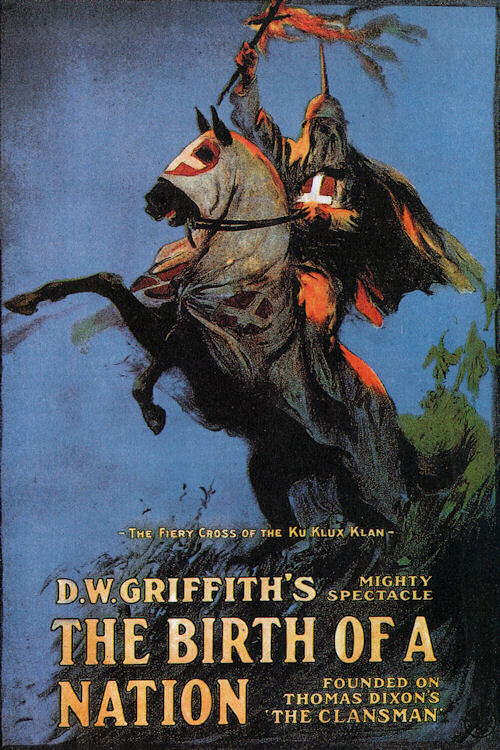Anthony's Film Review
The Birth of a Nation (1915)

D.W. Griffith's magnum opus, though blatantly controversial, excels in artistic and technical mastery...
It is pretty much an established fact that The Birth of a Nation, the 1915 silent film directed by D.W. Griffith and based on the novel The Clansmen by Thomas Dixon, Jr., cannot be reviewed with 100% objectivity, if one has any knowledge of American history. When you have a film that celebrates the white supremacist Ku Klux Klan as heroes and portrays African-Americans as ignorant, violent, and sexually aggressive people, strong feelings will no doubt emerge. It is hardly surprising to see members of the National Association for the Advancement of Colored People (NAACP) and the rest of the black community decry this film. Sadly, white supremacists, including those in the KKK, naturally praise this film and may use it as a recruiting tool.
I, too, feel that no person should be hated or discriminated against because of his or her racial background, and I strongly believe that hate groups, regardless of what their intentions may be, only do much more harm than good. Certainly, these opinions of mine can affect my review of The Birth of a Nation. At the same time, I still make an effort to be as objective as possible. As a result, the following review focuses on The Birth of a Nation as a work of art, with references to the film's content and messages playing a smaller yet still important role in my final rating of the movie.
Unlike other silent films at the time, The Birth of a Nation is a three-hour film instead of a motion picture lasting one hour or less. It really takes time to develop the story, characters, and setting, and it does so in two 90-minute halves. Act I spans the years before, during, and shortly after the Civil War, whereas Act II covers the Reconstruction period. In essence, The Birth of a Nation succeeds as an early 20th-century film that defines the epic film and sets the standard for feature-length films to come.
In Act I, the film introduces two families: the Stonemans who live in the North and the Camerons who live in the South in Piedmont, South Carolina. Here, we see members of the two families interacting with each other. This includes the formation of romantic relationships across the two families and the enlistment of the sons in opposite armies as the Civil War begins. I found this part of the movie interesting because it presents the good life before war breaks out. In fact, the blacks are portrayed only briefly in the first half as cotton pickers and as an all-black Southern regiment that ransacks people's homes.
I'd like to take a moment to talk about the look of the film. It is clear that director Griffith puts care into things like editing and production design. There are many scenes that consist of alternating camera shots instead of one continuous shot. This gives the film a more dynamic feel and makes it feel less stationary. For the Civil War battle scenes, he presents both panoramic shots and close-up shots. During scenes where many extras are being captured on film, you can tell that much money was invested for costumes, set design, and makeup (including, of course, blackface for white actors portraying blacks).
Act II begins after President Abraham Lincoln gets assassinated by John Wilkes Booth. The tone here clearly gets somber. Equality is guaranteed for blacks in the South, which allow them to play a major part in politics, so much that the whites feel like an oppressed minority. To make matters worse, there is a scene where Gus, a former slave, lustfully chases after one of the Cameron girls, Flora, who jumps to her death in fear. This leads one of the Cameron sons, who is bitter about losing the Civil War, to form the Ku Klux Klan. Later, the mulatto (half-white half-black) Lieutenant Governor of South Carolina, Silas Lynch, wishes to marry Elsie Stoneman despite her refusal.
I have to admit. The Birth of a Nation does have an interesting climax. For me, it was a mixture of anticipation for what would happen next and slight disgust as it involved the KKK saving the day and taking their land back from the blacks who are creating nothing but anarchy. The fact that the last 30 minutes could be engaging shows that D.W. Griffith was indeed a master filmmaker. As prejudiced as this film is, his artistic achievements here cannot be ignored.
Hence, I have no shame in giving D.W. Griffith's The Birth of a Nation a high rating. When you consider how this film's budget and ticket sales revenue exceeded those of other films at the time, you can't help but give the man credit. However, because of the blatantly racist content, I can't give it a 10 out of 10. Basically, it's a very good film that falls short from being perfect just because of its subject matter. If, instead of portraying a racial group in a negative light, The Birth of a Nation were to present something much more positive and timeless, I would give it a 10. But as it stands, it deserves a 9/10, one step away from a flawless classic.
Anthony's Rating:










For more information about The Birth of a Nation, visit the Internet Movie Database.
Home
Film Reviews
Other Reviews
Commentaries
Links
About AFR
RSS Feed
Privacy Policy
E-mail Anthony











